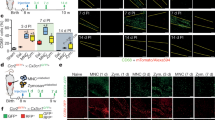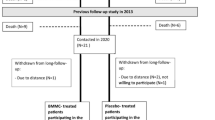Abstract
Cardiac stem cell therapy with bone-marrow-derived stem cells is a promising approach to facilitate myocardial regeneration after acute myocardial infarction or in congestive heart failure. The clinical data currently available seem to indicate that this approach is safe and is not associated with an increase in the number of adverse clinical events; nevertheless, the level of safety confidence is limited because of the small number of patients who have been treated and the absence of long-term clinical follow-up data. In order to establish the clinical safety of cardiac stem cell therapy, it will be necessary to collect additional data from both previous and ongoing clinical trials in subsets of patients relative to their background risk. Several conceptual safety concerns should also be addressed. These concerns relate to a number of operational mechanisms and include biological effects on differentiation, remote homing of transplanted stem cells, progression of atherosclerosis, and arrhythmias. The proactive scrutiny of these phenomena could eventually facilitate the translation of the promise of cardiac regeneration into a safe and effective therapy.
Key Points
-
The clinical data currently available indicate that cardiac stem cell therapy is safe
-
The level of safety confidence is limited, however, because of the small number of patients who have been treated and the absence of long-term clinical follow-up data
-
Several conceptual safety concerns should be addressed, including operational mechanisms (e.g. inappropriate myocardial biologic effects), remote homing of transplanted stem cells, controversy regarding progression of atherosclerosis, and arrhythmias
This is a preview of subscription content, access via your institution
Access options
Subscribe to this journal
Receive 12 print issues and online access
$209.00 per year
only $17.42 per issue
Buy this article
- Purchase on Springer Link
- Instant access to full article PDF
Prices may be subject to local taxes which are calculated during checkout


Similar content being viewed by others
References
Givertz MM et al. (2005) Clinical aspects of heart failure; pulmonary edema, high-output failure. In Braunwald's Heart Disease: A Textbook of Cardiovascular Medicine, edn 7 539–568 (Eds Zipes DP et al.) Philadelphia: Elsevier Saunders
Strauer BE et al. (2002) Repair of infarcted myocardium by autologous intracoronary mononuclear bone marrow cell transplantation in humans. Circulation 106: 1913–1918
Schachinger V et al. (2004) Transplantation of progenitor cells and regeneration enhancement in acute myocardial infarction: final one-year results of the TOPCARE-AMI Trial. J Am Coll Cardiol 44: 1690–1699
Fernandez-Aviles F et al. (2004) Experimental and clinical regenerative capability of human bone marrow cells after myocardial infarction. Circ Res 95: 742–748
Wollert KC et al. (2004) Intracoronary autologous bone-marrow cell transfer after myocardial infarction: the BOOST randomised controlled clinical trial. Lancet 364: 141–14875
Bartunek J et al. (2005) Intracoronary injection of CD133+ enriched bone marrow progenitors promotes cardiac recovery after recent myocardial infarction: feasibility and safety. Circulation 112 (Suppl 1): I178–I183
Janssens S et al. (2006) Transplantation of autologous bone marrow-derived stem cells in patients with ST-segment elevation myocardial infarction: double-blind, randomised controlled trial. Lancet 367: 113–121
Schachinger V et al. (2006) Intracoronary bone marrow-derived progenitor cells in acute myocardial infarction. N Engl J Med 355: 1210–1221
Lunde K et al. (2006) Intracoronary injection of mononuclear bone marrow cells in acute myocardial infarction. N Engl J Med 355: 1199–1209
Meyer PA et al. (2006) Intracoronary bone marrow cell transfer after myocardial infarction: eighteen months' follow-up data from the randomized, controlled BOOST (BOne marrOw transfer to enhance ST-elevation infarct regeneration) trial. Circulation 113: 1287–1294
Perin EC et al. (2003) Transendocardial, autologous bone marrow cell transplantation for severe, chronic ischemic heart failure. Circulation 107: 2294–2302
Stamm C et al. (2004) CABG and bone marrow stem cell transplantation after myocardial infarction. Thorac Cardiovasc Surg 52: 152–158
Strauer B et al. (2005) Regeneration of human infarcted heart muscle by intracoronary autologous bone marrow cell transplantation in chronic coronary artery disease: the IACT Study. J Am Coll Cardiol 46: 1651–1658
Volpi A et al. (2001) Incidence and short-term prognosis of late sustained ventricular tachycardia after myocardial infarction: results of the Gruppo Italiano per lo Studio della Sopravvivenza nell'Infarto Miocardico (GISSI-3) Data Base. Am Heart J 142: 87–92
Wang JS et al. (2000) Marrow stromal cells for cellular cardiomyoplasty: feasibility and potential clinical advantages. J Thorac Cardiovasc Surg 120: 999–1005
Yoon YS et al. (2004) Unexpected severe calcification after transplantation of bone marrow cells in acute myocardial infarction. Circulation 109: 3154–3157
Olson E (2004) A decade of discoveries in cardiac biology. Nat Med 10: 467–474
Beeres SL et al. (2005) Human adult bone marrow mesenchymal stem cells repair experimental conduction block in rat cardiomyocyte cultures. J Am Coll Cardiol 46: 1943–1952
Chang MG et al. (2006) Proarrhythmic potential of mesenchymal stem cell transplantation revealed in an in vitro coculture model. Circulation 113: 1832–1841
Hou D et al. (2005) Radiolabeled cell distribution after intramyocardial, intracoronary, and interstitial retrograde coronary venous delivery: implications for current clinical trials. Circulation 112 (Suppl 1): I150–I156
Hofmann M et al. (2005) Monitoring of bone marrow cell homing into the infarcted human myocardium. Circulation 111: 2198–2202
Penicka M et al. (2005) Images in cardiovascular medicine. Early tissue distribution of bone marrow mononuclear cells after transcoronary transplantation in a patient with acute myocardial infarction. Circulation 112: e63–e65
Epstein SE et al. (2004) Janus phenomenon: the interrelated tradeoffs inherent in therapies designed to enhance collateral formation and those designed to inhibit atherogenesis. Circulation 109: 2826–2831
Hill JM et al. (2003)Circulating endothelial progenitor cells, vascular function, and cardiovascular risk. N Engl J Med 348: 593–600
Rauscher FM et al. (2003) Aging, progenitor cell exhaustion and atherosclerosis. Circulation 108: 457–463
Sata M et al. (2002) Hematopoietic stem cells differentiate into vascular cells that participate in the pathogenesis of atherosclerosis. Nat Med 8: 403–409
Silvestre JS et al. (2003) Transplantation of bone marrow-derived mononuclear cells in ischemic apolipoprotein E-knockout mice accelerates atherosclerosis without altering plaque composition. Circulation 108: 2839–2842
George J et al. (2005) Transfer of endothelial progenitor and bone marrow cells influences atherosclerotic plaque size and composition in apolipoprotein E knockout mice. Atherioscler Thromb Vasc Biol 25: 2636–2641
Kang HJ et al. (2004) Effects of intracoronary infusion of peripheral blood stem cells mobilised with granulocyte-colony stimulating factor on left ventricular systolic function and restenosis after coronary stenting in myocardial infarction: the MAGIC cell randomised clinical trial. Lancet 363: 751–756
Mansour S et al. (2006) Intracoronary delivery of hematopoietic bone marrow stem cells and luminal loss of the infarct-related artery in patients with recent myocardial infarction. J Am Coll Cardiol 47: 1727–1730
Richel DJ et al. (2000) Highly purified CD34+ cells isolated using magnetically activated cell selection provide rapid engraftment following high-dose chemotherapy in breast cancer patients. Bone Marrow Transplant 25: 243–249
Bartunek J et al. (2006) The consensus of the task force of the European Society of Cardiology concerning the clinical investigation of the use of autologous adult stem cells for repair of the heart. Eur Heart J 27: 1338–1340
Acknowledgements
We acknowledge the contribution of Drs Samer Mansour, Steven Vercauteren, and Giovanna Sarno to our clinical studies on coronary cell transfer. We also thank Dr Ike Lee for thoughtful comments on the manuscript.
Author information
Authors and Affiliations
Corresponding author
Ethics declarations
Competing interests
J Bartunek, W Wijns, G Heyndrickx, and M Vanderheyden are members of a non-profit organization which is a founding member of Cardio3, a start-up company. F Timmermans, B Vandekerkhove, A Villa, PL Sanchez, R Arnold, JA San Roman, and F Fernandez-Aviles declared they have no competing interests.
Rights and permissions
About this article
Cite this article
Bartunek, J., Vanderheyden, M., Wijns, W. et al. Bone-marrow-derived cells for cardiac stem cell therapy: safe or still under scrutiny?. Nat Rev Cardiol 4 (Suppl 1), S100–S105 (2007). https://doi.org/10.1038/ncpcardio0744
Received:
Accepted:
Issue Date:
DOI: https://doi.org/10.1038/ncpcardio0744



